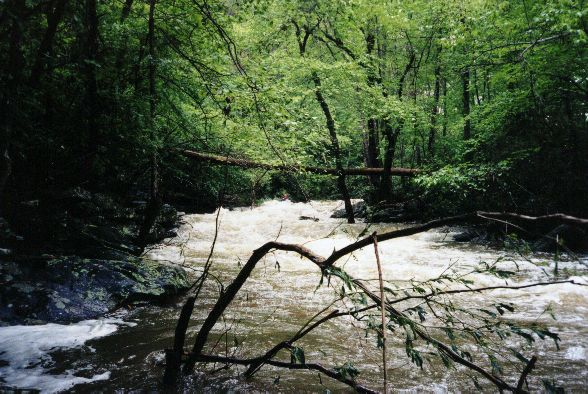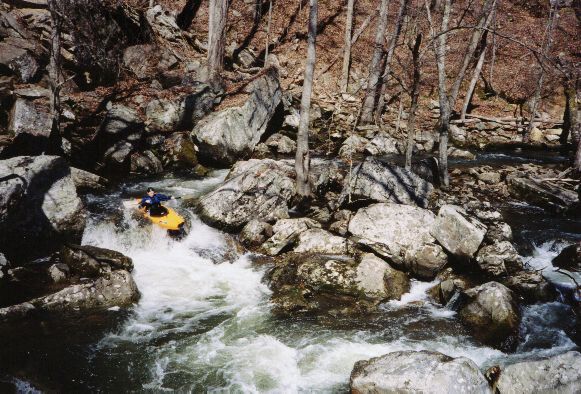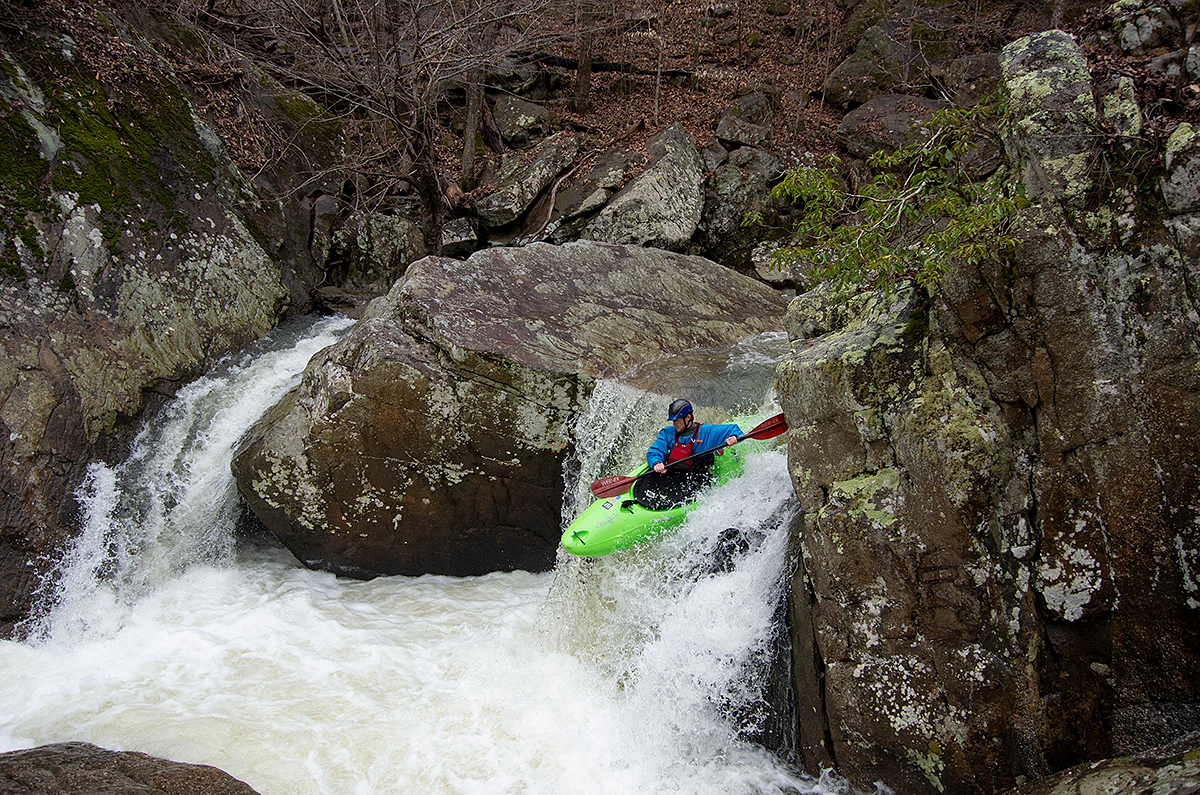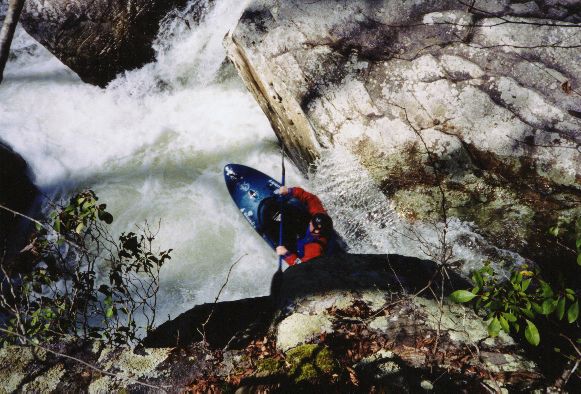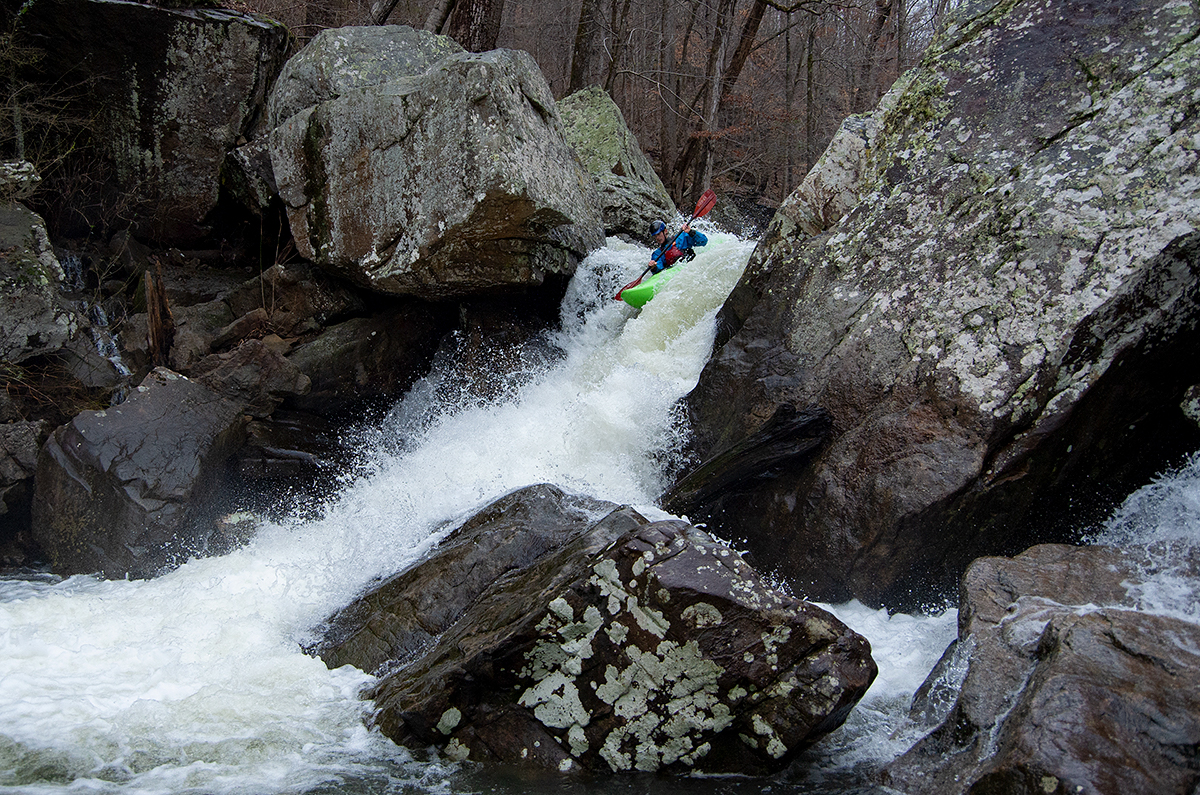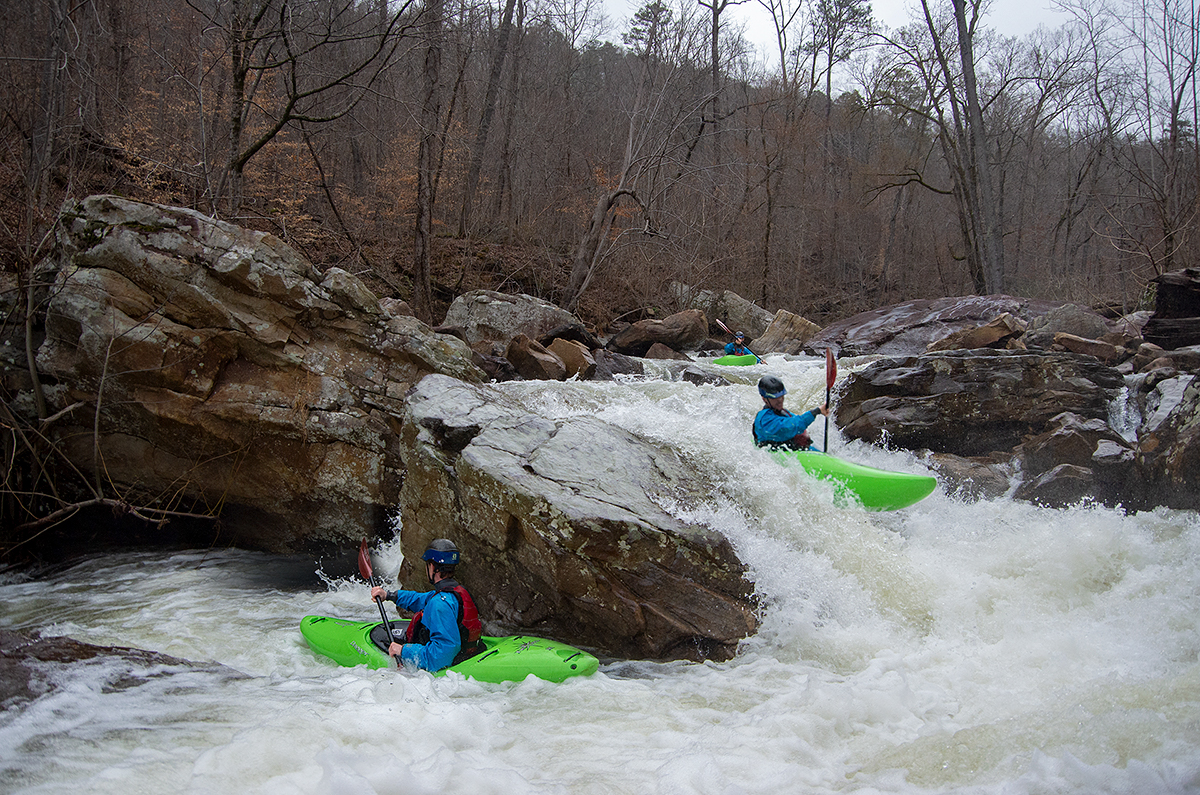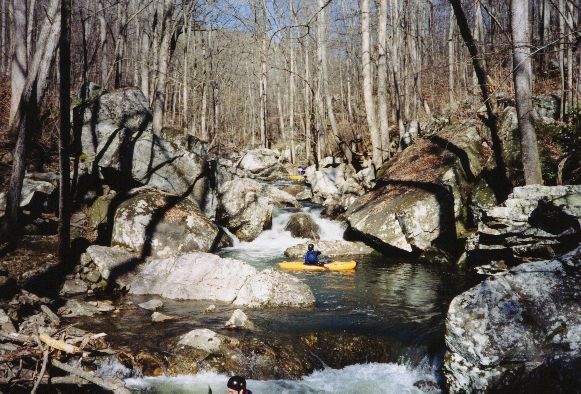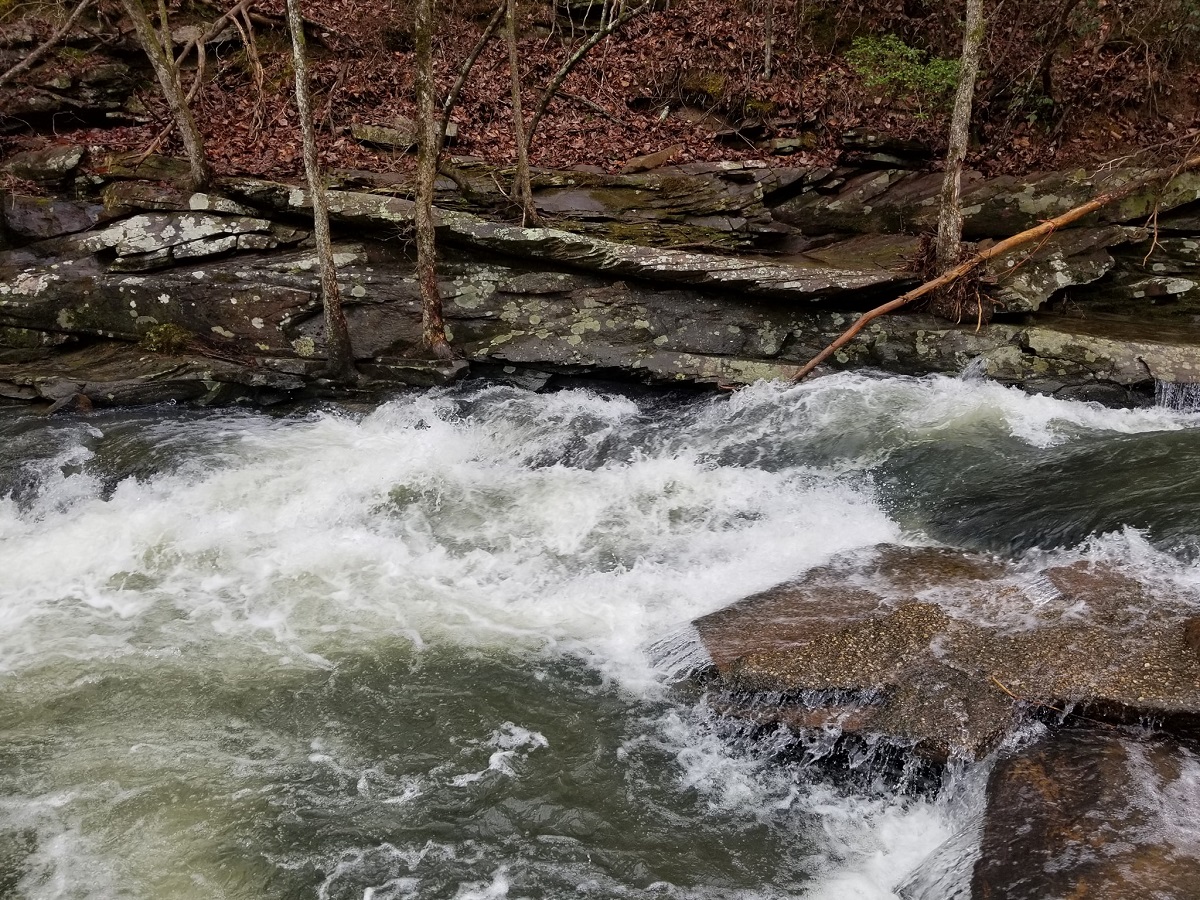Dry Creek (Sauty)
-
RunDry Creek (Sauty)
-
ClassV
-
Put InCR 44
-
Take OutMorgan's Cove Boat Ramp
-
Length (mi)2.5
-
Gradient (fpm)160, 260, 20
-
Watershed (mi2)12.8
-
Primary Gage
- Put-in rapid Flow over flat rock
-
Indicator Gage
- S. Sauty Buck's Pocket Stick 18"+ (new gage)
- Town Creek near Geraldine 1000 cfs
Description
Dry (Sauty) is somewhere between Johnnies and Jones in difficulty. It's a small creek which has some big drops formed by enormous boulders. Though the watershed is tiny, similar to Teddy Bear on Lookout Mountain, it seems to hold longer, and may still be runnable for 2 days after a big rain event if you have a high tolerance for rocks and logs. The first small rapid an easy hike about 25 yards downstream of the (new) bridge. As long as there is a decent film of water going over the flat rock on the left, you can make it down, though the runout through the trees at the end is not pretty.
Dry starts with some class III/IV with undercuts (see pictures) right at the top. The first of these is a small 5' blind drop which takes a sharp turn to the right and out of sight. A cool slide beneath a huge balanced boulder follows, as well as some more low volume easy stuff. The first longer rapid is in a left-hand bend of the creek, where you'll work through some smaller entrance drops over to a defined 4' ledge on the right.
Following that, several steep class V rapids with undercuts, sieves, falls, holes, etc. can be found. The first of these begins with a very undercut slot into an eddy above a super slick cauldron drop. The whole thing can be scouted or walked on the left, but you can portage the entrance slot on the right and still run the main drop, an 8' shoulder boof into a boxed in pool. There are hazards in the landing area here so be sure to set safety (on the left) and keep your momentum going straight for the outflow down a narrow hallway. The next two drops are best scouted together, on the right. The first is a small boxed in hole, but immediately following a small moving pool is the largest vertical drop on the creek. This two-tiered fifteen footer looks ugly and is often portaged, but has been run successfully at least twice. Take a long look before committing, and if you decide to walk the portage on the left isn't bad after running the smaller drop upstream.
Below here, the gradient eases slightly and several fun III/IV rapids are encountered. The most memorable begins with a long entrance into a ramping boof to avoid a hole on the left. However, it is highly advised to catch the eddy on the left beneath the hole, to avoid being stuffed into a small pin-prone slot directly beneath the boof. If you succeed, ferry out and across the current to a cool part of the drop which briefly travels back upstream before making a banking turn to end the rapid. After a few more small rapids, the final drop ends the steep section with a bang. At good water, this one may actually have several runnable lines, but at low flow the only option is to the left of a small island over a small 4' ledge. After another brief pool, the lower section of the drop is a narrow tongue over a 6' boulder drop, turning right immediately after landing to rejoin the flow from the right side and bang down some rocks. Below here the creek quickly loses steam and begins to braid badly. At low water, this is where you'll begin having regrets, as there are LOTS of downed logs and shallow channels in this section. We actually had to walk our boats down the creek at one point at the level shown in the new photos. After you reach the lake, hang a left to find your car parked at Morgan's Cove.
The shuttle is long for Sand Mountain, about 19 miles one way, but only takes 30 min. Be sure your GPS routes you around Buck's Pocket, and not over the low water bridge, which will likely be several feet underwater when Dry is in. As of February 2022, all of the main drops are clear of wood, and only a small ledge in the middle of the steep section required a portage. The runout was messy but worth it for the drops upstream. The gauge is gone after the put-in bridge was replaced, and there aren't any pilings in the water to facilitate an easy replacement. Several pictures have been added of the put-in before our recent run; these illustrate the lowest acceptable flow. Be warned, running this with too much water might be more excitement than you want. It does not take that much. The water quality is surprisingly good for Sand Mountain, and actually has more of a blue tint than that famous chicken poop brown.
Details
-
ClassV
-
Gradient (fpm)160, 260, 20
-
Length (mi)2.5
-
Watershed Size (mi2)12.8
-
Put InCR 44
-
Take OutMorgan's Cove Boat Ramp
-
ShuttleCR 44 / CR 38 / CR 43-56 / CR 43 / CR 50 / SR 227 / Boat Ramp
-
Water Quality
 (
2 chickens | 1 = Good, 3 = Gross)
(
2 chickens | 1 = Good, 3 = Gross)
-
Primary Gage
- Put-in rapid Flow over flat rock
-
Indicator Gage
- S. Sauty Buck's Pocket Stick 18"+ (new gage)
- Town Creek near Geraldine 1000 cfs
-
Precip. Gage
Map
Video
Photos
Trip Reports
Dry (Sauty) Creek
February 24, 2022
Written by Kellis Kincaid & Riley Carroll
Wednesday (the 23rd) was the good boating day this week, with several inches falling across the state overnight and into the morning hours. As always is the case, we were too busy to boat that day, and had to settle for the next. We awoke to the classic scenario of big flows on all the main creek stems, but the likely sad reality of the flow being gone for most of the interesting micro creeks. Fortunately we spotted an interesting tidbit on the AL WW site: it claimed that Dry (Sauty) Creek might potentially be runnable for two days after a rain. Better than Short or Sauty, we thought, so we headed to the put-in to check the level.
Upon getting to the bridge, we weren't sure how to judge the flow, as the old bridge gauge was destroyed when the new structure was put up. We hiked down to the first rapid, only about 25 yards from the bridge, and it looked runnable. A thin but constant film of water was flowing over the flat rock on the left; this would be about as low as you'd want to go. After a long but relatively painless shuttle (don't let your GPS route you over the low water bridge in Buck's Pocket), we put on, not sure what to expect. The last update we had heard about the creek was that Kyle Hulsey had tried to run it a few years ago, and every major rapid had been shut down with wood. Fortunately the creek is only 2.5 miles long, giving us enough time to scout the blind drops and not risk getting stuffed into a log jam.
The top section started off with a bang, when Riley washed backwards down the first drop which hooked hard to the right and out of sight. Fortunately it was all clear, and we assumed a slightly more cautious pace moving forward. This section was low but manageable, and had a few cool drops including a small slide underneath an enormous boulder balanced on one of its corners. The first longer drop comes in a left-hand bend. We scouted left, revealing an easy line through some small rocks and under a log to a defined 4' ledge on the right. This signals the start of the steep section, where the next rapid kicks off with a super undercut slot into an eddy. We scouted left above the slot, which turned out to be the entrance to the sick cauldron drop from the AL WW pics. After looking at the slot up close, we decided to walk it on the right by ferrying across back upstream, so we could put into the eddy above the cauldron and run the main drop. There were some bad spots on both sides at the bottom of the drop, so be sure one person sets safety from the left side while others run it. Riley had some trouble getting out of the room so try to carry momentum off the drop and through the exit hallway, but watch out for the undercut/cave on the right.
Below here were two drops which we scouted (right) at the same time. The first was a small one over a boxed-in hole, leading to a small pool. The next drop is the big 15 footer, which is actually a two part vertical which lands on a rock on the left 75% of the landing zone. I didn't like the look of it, and wasn't sure I could get enough momentum to the right to miss a bad piton or worse. Riley decided to run it though, so I set safety after running the small rapid above and portaging left. He ended up having a great line, but I have heard that some previous lines almost ended in a bounce backwards off the rock into the curtain (or whatever is behind the drop). Definitely worth a long look before committing.
Downstream the drops got a little smaller, mostly tight boulder gardens. There was one very cool drop, requiring one to boof off a slanted rock far right and power into an eddy far left to miss getting stuffed into a narrow crack (scout left). I blew the move and got stuffed, but fortunately we had pulled the wood out of the slot when scouting. Riley nailed it, and made the exit move where you ferry back across the current and then follow the water back upstream and around an airplane turn of sorts. Very cool.
The steep section ended with the largest rapid besides the 15 footer, and perhaps the only one which might have multiple lines at high water (scout right). At low flow, the only option was to the left of an island in the middle, over a small ledge and into a moving pool. Then we had to finish out by driving over a slanted boulder and turning hard right at the bottom, rejoining the flow from the right. Below here the nightmare started, as the creek began to braid and a good part of the flow seemed to disappear into the ground. Imagine the forest section on South Sauty proper, but with 10 cfs and the creek is 10 feet wide. There were downed trees every 10 or 20 yards, and we had to make 5-10 walks in this section, including a particularly bad part where we gave up and just walked our boats through the water for 50 yards or so. As if that wasn't bad enough, I got back into my boat to run the last little riffle and put a big crack in the bottom thanks to a poorly placed rock. Fortunately we arrived at the lake, where we took a left and a short paddle led back to the car at Morgan's Cove.
At this level, the top section was low but bearable, and the steep section was a great first-time level, but the runout was extremely painful. We still had significantly more flow than is shown in the old photos, so I don't know how on earth they made it through the runout. It was a great run with some very cool drops, but I would want more water before going back. The description is right though, I don't think I would want much more water than we had or things might start to get sketchy, particularly the cauldron drop which I think was the standout rapid on the run. This might lead to a delicate balance between running it directly after a smaller rain event (say, 1.5-2") or two days after a larger rain event, like we did (2.5"+ according to radar data). You'll have to take a look at the put-in and compare to the pictures we posted on the site before making a decision, but it would be a top tier run if you caught it with the right water level.
